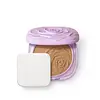KIKO Milano Blossoming Beauty Hydrating & Long Lasting Blurring Effect Foundation Versus L'Oreal Infallible Fresh 24H Wear Foundation In A Powder
What's inside
What's inside
 Key Ingredients
Key Ingredients

 Benefits
Benefits

 Concerns
Concerns

 Ingredients Side-by-side
Ingredients Side-by-side

Mica
Cosmetic ColorantCaprylic/Capric Triglyceride
MaskingDimethicone
EmollientStearalkonium Hectorite
Gel FormingSilica
AbrasivePropylene Carbonate
SolventDimethicone/Vinyl Dimethicone Crosspolymer
Skin ConditioningSynthetic Fluorphlogopite
Dehydroacetic Acid
PreservativeMethicone
EmollientDimethiconol
EmollientTriethoxycaprylylsilane
Ethyl Vanillin
MaskingMagnolia Officinalis Bark Extract
AntimicrobialCI 77891
Cosmetic ColorantCI 77491
Cosmetic ColorantMica, Caprylic/Capric Triglyceride, Dimethicone, Stearalkonium Hectorite, Silica, Propylene Carbonate, Dimethicone/Vinyl Dimethicone Crosspolymer, Synthetic Fluorphlogopite, Dehydroacetic Acid, Methicone, Dimethiconol, Triethoxycaprylylsilane, Ethyl Vanillin, Magnolia Officinalis Bark Extract, CI 77891, CI 77491
Talc
AbrasiveZinc Stearate
Cosmetic ColorantDimethicone
EmollientZea Mays Starch
AbsorbentCaprylic/Capric Triglyceride
MaskingSilica
AbrasiveDimethicone/Vinyl Dimethicone Crosspolymer
Skin ConditioningTriethoxycaprylylsilane
Caprylyl Glycol
EmollientEthylhexylglycerin
Skin ConditioningPotassium Sorbate
PreservativeParfum
MaskingIsoceteth-10
EmulsifyingAlaria Esculenta Extract
Skin ProtectingHexyl Cinnamal
PerfumingBenzyl Salicylate
PerfumingLinalool
PerfumingAlpha-Isomethyl Ionone
PerfumingBenzyl Alcohol
PerfumingCitronellol
PerfumingTocopherol
AntioxidantCI 77891
Cosmetic ColorantCI 77491
Cosmetic ColorantCI 77492
Cosmetic ColorantCI 77499
Cosmetic ColorantMica
Cosmetic ColorantCI 19140
Cosmetic ColorantCI 77007
Cosmetic ColorantCI 15850
Cosmetic ColorantTalc, Zinc Stearate, Dimethicone, Zea Mays Starch, Caprylic/Capric Triglyceride, Silica, Dimethicone/Vinyl Dimethicone Crosspolymer, Triethoxycaprylylsilane, Caprylyl Glycol, Ethylhexylglycerin, Potassium Sorbate, Parfum, Isoceteth-10, Alaria Esculenta Extract, Hexyl Cinnamal, Benzyl Salicylate, Linalool, Alpha-Isomethyl Ionone, Benzyl Alcohol, Citronellol, Tocopherol, CI 77891, CI 77491, CI 77492, CI 77499, Mica, CI 19140, CI 77007, CI 15850
Ingredients Explained
These ingredients are found in both products.
Ingredients higher up in an ingredient list are typically present in a larger amount.
This ingredient is an emollient, solvent, and texture enhancer. It is considered a skin-softener by helping the skin prevent moisture loss.
It helps thicken a product's formula and makes it easier to spread by dissolving clumping compounds.
Caprylic Triglyceride is made by combining glycerin with coconut oil, forming a clear liquid.
While there is an assumption Caprylic Triglyceride can clog pores due to it being derived from coconut oil, there is no research supporting this.
Learn more about Caprylic/Capric TriglycerideCi 77491 is also hydrated iron III oxide. It's sole purpose is to give a red/pink hue to products.
Iron III oxides are classified as inorganic chemicals for coloring.
Synthetically created Ci 77491 is considered safer than those naturally found. This is because the synthetically created version may contain less impurities. Iron oxides are generally non-toxic and non-allergenic.
Learn more about CI 77491Ci 77891 is a white pigment from Titanium dioxide. It is naturally found in minerals such as rutile and ilmenite.
It's main function is to add a white color to cosmetics. It can also be mixed with other colors to create different shades.
Ci 77891 is commonly found in sunscreens due to its ability to block UV rays.
Learn more about CI 77891Dimethicone is a type of synthetic silicone created from natural materials such as quartz.
What it does:
Dimethicone comes in different viscosities:
Depending on the viscosity, dimethicone has different properties.
Ingredients lists don't always show which type is used, so we recommend reaching out to the brand if you have questions about the viscosity.
This ingredient is unlikely to cause irritation because it does not get absorbed into skin. However, people with silicone allergies should be careful about using this ingredient.
Note: Dimethicone may contribute to pilling. This is because it is not oil or water soluble, so pilling may occur when layered with products. When mixed with heavy oils in a formula, the outcome is also quite greasy.
Learn more about DimethiconeThis ingredient is a silicone used to improve the texture of products and absorb oil. It does not get absorbed into the skin.
Like other silicones, Dimethicone/Vinyl Dimethicone Crosspolymer helps condition the skin by creating a barrier. In this sense, it can act as an emollient and trap moisture in.
This ingredient is a type of elastomer.
Learn more about Dimethicone/Vinyl Dimethicone CrosspolymerMica is a naturally occurring mineral used to add shimmer and color in cosmetics. It can also help improve the texture of a product or give it an opaque, white/silver color.
Serecite is the name for very fine but ragged grains of mica.
This ingredient is often coated with metal oxides like titanium dioxide. Trace amounts of heavy metals may be found in mica, but these metals are not harmful in our personal products.
Mica has been used since prehistoric times throughout the world. Ancient Egyptian, Indian, Greek, Roman, Aztec, and Chinese civilizations have used mica.
Learn more about MicaSilica, also known as silicon dioxide, is a naturally occurring mineral. It is used as a fine, spherical, and porous powder in cosmetics.
Though it has exfoliant properties, the function of silica varies depending on the product.
The unique structure of silica enhances the spreadability and adds smoothness, making it a great texture enhancer.
It is also used as an active carrier, emulsifier, and mattifier due to its ability to absorb excess oil.
In some products, tiny microneedles called spicules are made from silica or hydrolyzed sponge. When you rub them in, they lightly polish away dead skin layers and enhance the penetration of active ingredients.
Learn more about SilicaTriethoxycaprylylsilane is a silicone used to bind and stabilize ingredients.
As an emulsifier, it helps prevent ingredients from separating. This can help elongate the shelf life of products.
Triethoxycaprylylsilane is often used to coat mineral sunscreens ingredients to help give a better feel. It also helps reduce oxidative stress in sunscreens.
Learn more about Triethoxycaprylylsilane